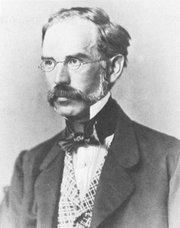This article is part of the series "A Moment in History" where we honor those who have contributed to the growth of medical knowledge in the areas of anatomy, medicine, surgery, and medical research.

Dr. Václav Treitz
UPDATED: Dr. Václav Treitz (1819 - 1872). Also known as Wenzel Treitz, Dr. Václav Treitz was born in Hostomice, Bohemia. He attended the Charles-Ferdinand University in Prague studying humanities and medicine, receiving his medical degree in 1846. Treitz started postgraduate work at the Vienna General Hospital (Allgemeines Krankenhaus), where Joseph Skoda (1805-1881) was a proponent of “therapeutic nihilism” which stated that “drug treatment usually does more harm than good”, so a minimalistic or even pessimistic approach to diseases was used.
Large numbers of women at this hospital died of “puerperal fever” an postpartum uterine infection due to contamination by the unwashed hands of physicians and utter lack of cleanliness (septic technique had not been yet described). It was during Treitz’s time at the Vienna General Hospital that Ignaz Philipp Semmelweis (1818 – 1865) stated his initial observations on asepsis. Treitz later became a follower of Semmelweis’ and Lister’s teachings and techniques.
In 1852 Treitz was appointed Professor of Pathological Anatomy in the Jagellonian University in Prague.
In 1853 he published a paper ("Ueber einen neuen Muskel am Duodenum des Menschens" ) describing a new muscle he discovered at the duodenojejunal junction, later to be known as the eponymic “muscle of Treitz”; the fold of peritoneum over the muscle of Treitz is known today as the "ligament of Treitz". Treitz also described a paraduodenal retroperitoneal hernia that occurs at the paraduodenal recess, just lateral to the ligament of Treitz.
A staunch proponent of Czechoslovakian independence and language, Treitz was publicly attacked for his medical theories and nationalistic beliefs. Isolated and depressed, Treitz committed suicide in 1872.
The article on the "Ligament of Treitz" is the most popular article in "Medical Terminology Daily" with over 152 thousand hits!
Sources:
1. "Václav Treitz (1819-1872): Czechoslovakian Pathoanatomist and Patriot” Fox, RS; Fox, CG; Graham, WP. World J. Surg. 9, 361-366, 1985
2. "Treitz of the ligament of Treitz". Haubrich, W S. (2005) Gastroenterology, 128 (2), 279
3. "Preserving Treitz's muscle in hemorrhoidectomy". Gemsenj?ger, E Diseases of the Colon & Rectum (1982), 25 (7), p. 633.
4. “The Muscle Of Treitz And The Plica Duodeno-Jejunalis” Crymble, PT. The British Medical Journal, Vol. 2, No. 2598 (1910), 1156-1159
Original image, public domain, courtesy of .



